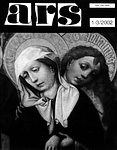
Journal ARS 35 (2002) 1-3
Petra HANÁKOVÁ
Teoretická kritika (modernistického) múzea umenia – exemplárny terč newyorské MoMA (The Museum of Modern Art)[Theoretical Critique of (Modernist) Museum of Art – an Exemplary Target New York's MoMA (The Museum of Modern Art)]
(Summary)
The essay sets a goal to mediate a reader some current trends of the interdisciplinary studies in the western cultural world known as critical museology.
The essay's starting point is the consideration: Slovak ausstellungsmacherei has only partially registered that the change of conceptual frame and paradigm, mentioned in a connection of postmodernism, has a great influence on the museology.
Talking about the museology I mean mainly: different ways works of art are structured in a permanent exhibition, different writing and story-telling strategies presented by show exhibits. In short, I think about some of the new trends within museum aussellungsmacherei.
For instance, one of these trends is a continual replacement of a permanent exhibition (or collection presentation - grand récit in Lyotard's sense) by temporary exhibitions (in favour of more partial and less authoritative small regional "stories").
Another example of these trends is a certain resignation on linear and chronologically structured exhibitions in favour of a-historical, mostly thematic exhibitions and also a move from formalistic "pure" presentations towards evocation within broader cultural context of art.
Despite the museum and exhibition making are nowadays hot topics in the western cultural world with a lot of literature collected, in Slovakia, they are discussed only rarely. At the same time the museum of art is one of the most crucial expressions of art history and their most significant representative. In the special way of thinking it is also a creator of art history. Furthermore, if we accept the Donald Preziosi's opinion, who is talking about the reciprocal dependence on invention of art by invention of museum of art, also the creator of art itself, art of art history.
The same relation of reciprocity does exist between the critique of museum as a representative institution (or the institution of representation) and the critique of art history itself. Imaginary discourse field of the museum's critique thus becomes so-called champ de bataille - a battlefield of new ideas within art history.
This discourse field, mentioned earlier, either on the ground of so called critical exhibitions or on the pages of critical texts is too broad to be covered by a limited number of this article's pages. For that reason I rather narrow the selected frame and focus my attention only on one museum, an exemplary and illustrative example, through its model history I try to demonstrate some of dominant characteristic features not only of post-modern museum's critique but also of modernistic museology.
The analysed example is the Museum of Modern Art (MoMA) in New York, one of the greatest authorities among museums of art. The main reason for choosing this institution originates in the fact that MoMA is the only institution that can offer so many possibilities of de- constructive reading and learning about characteristic, "structural" features of museum's history of modern art.
The essay briefly surveys the establishment of the institution and the activities of its first director Mr. A. H. Barr Jr. It also pays attention to the first great MoMa exhibitions under which the profile of institution is formed and later has become one of the most powerful museum institution in the world. After mentioning the first period of early modernism the essay focuses on the so-called Rubin period characterised by institutionalising of avant-garde. Afterwards, the topic is related to the more recent history (under Varnedoe leadership), already expressing features of post-modern institutional critiques.
Eventually, the essay deals with critical history of the institution, "read" through the filter of the most important critical texts on this powerful institution in the last decades of the 20th century (feminist MoMA critique written by Carol Duncan and Allan Wallach, O'Doherty's critique of museum as so-called white cube, postmodern critique of framing stereotypes by Reesa Greenberg etc....).
The text follows continuity of building extensions and re-installations. In the end, special attention is given to the current activities of this institution which in the past served as a trendsetter within modern art and its museology and also helped to construct its modernist history. The aim of this text is to articulate (and on the example of MoMA to illustrate) a narrow and reciprocal connection between a museum and the history of art (and between the changes in the framework of the museum and the changes in the framework of art history).
The similar mirror-like relation can be identified between writing (and current re-writing) of art history through texts of art historians and art history writing by means of exhibitions and revisionist arrangement of objects in the exposition. In other words, the exhibition making has also its phase of new art history, and the end of (traditional and teleological) history of art has its exhibition parallel. This parallel in the context of current museums of art is the end of the permanent exhibition.